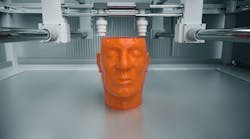Shielding Intellectual Property from 3-D Printing's Paradigm Shift
Our world is changing. As 3-D printing evolves, we inch closer and closer to a technological threshold that many believe will usher in a new industrial revolution. Today, 3-D printers are becoming commonplace—from industrial to personal use. For example, they are used to fabricate medical devices and pharmaceutical products, electronic components, and automobile and airplane parts. They can even be found at some construction sites, and are employed in countless creative ways in the high fashion and culinary worlds.
The reason 3-D printers have pervaded so many industries is because they enable faster and cheaper prototyping and allow manufacturers to more quickly and easily build complex products that formerly required custom molds or other machinery. Their popularity has also soared because 3-D printers enable widely varying types of objects to be fabricated without significant upfront investment. Products may be customized much more cheaply. Developing customer-specific products that offer added levels of utility and safety is far more feasible using 3-D printing. Moreover, 3-D printers enable smaller manufacturers—and even individuals—to create products with the caliber previously limited to larger manufacturers. This incentivizes ingenuity and helps eliminate barriers to market entry.
As mentioned, 3-D printing is not limited to traditional manufacturing applications. Using widely available printers, members of the general public can effortlessly produce exact copies of countless types of three-dimensional objects—items ranging from telephone cases to electronics components, and even firearms. Despite the endless possibilities and concomitant temptations, however, not many individuals are currently using 3-D printers to make copies of copyrighted works—at least not enough to make an appreciable dent in most copyright holders’ bottom lines. That day may soon come, though, when 3-D printers occupy the homes of tens of millions of Americans. 3-D printers stand to follow the same paths as dot-matrix printers, then inkjet printers, then laser printers. And once companies start attributing depressed bottom lines to unauthorized 3‑D printing, copyright holders will invariably look for ways to push back. But against whom will they push back to regain control over their intellectual property?
If history serves as a guide, it’s reasonable to predict that some will go after the individuals who fabricate unauthorized copies—much like the music industry did in the early and mid-2000s for unauthorized music sharing. But as a public-relations matter, many companies would likely find the optics of such an approach less than appealing. And the overall effectiveness of such a strategy is debatable at best, given that digital music is commonly sold today in the MP3 format, free of digital-rights-management technology.
Another option is to go after 3-D printer manufacturers under theories of contributory copyright infringement given that they produce and market the devices that make the infringement possible. Though the optics of this approach are much more palatable than suing individual 3-D printer users, would the argument against 3-D printer manufacturers hold water? We have a guide from when another nascent technology was making waves.
In the 1970s, Sony developed the Betamax video tape recording format. Threatened by this new technology and the risk that it posed to their intellectual property, Universal Studios and the Walt Disney Company sued Sony for contributory infringement, alleging that Sony’s recorders had been used by members of the general public to record copyrighted television programs, thereby infringing Universal’s and Disney’s copyrights. See Sony Corp. of Am. et al., v. Universal City Studios, Inc. et al., 464 U.S. 417, 420 (1980). The plaintiffs “sought money damages and an equitable accounting of profits” from Sony, as well as an “injunction against the manufacture and marketing” of Betamax video tape recorders. Id. After a trial, the United States District Court for the Central District of California entered judgment in Sony’s favor. Id. On appeal, the Ninth Circuit reversed the District Court’s judgment and held Sony liable for contributory infringement. Id.
On certiorari, the Unites States Supreme Court reversed. The court reasoned that “the sale of copying equipment, like the sale of other articles of commerce, does not constitute contributory infringement if the product is widely used for legitimate, unobjectionable purposes. Indeed, it need merely be capable of substantial noninfringing uses.” Id. at 442. The court further explained that if a copier were used to make copies of copyrighted works for a commercial or profit-making purpose, such use would presumptively be unfair. Id. at 449. But a contrary presumption would arise where the copies are made for a noncommercial, nonprofit activity. Id. Moreover, according to the court, though “every commercial use of copyrighted material is presumptively an unfair exploitation of the monopoly privilege that belongs to the owner of the copyright, . . . [a] challenge to a noncommercial use of a copyrighted work requires proof either that the particular use is harmful, or that if it should become widespread, it would adversely affect the potential market for the copyrighted work.” Id. at 451. The court concluded that “Sony demonstrated a significant likelihood that substantial numbers of copyright holders who license their works for broadcast on free television would not object to having their broadcasts time-shifted by private viewers.” Id. at 456. The court also noted that Universal and Disney “failed to demonstrate that time-shifting would cause any likelihood of nonminimal harm to the potential market for, or the value of, their copyrighted works.” Id.
So could a copyright holder like, say, the maker of a phone case, prevail in a suit alleging contributory copyright infringement against the manufacturer of a popular home 3-D printer? As with many other things in life, the answer depends on the specifics of the case. If that particular printer (1) is capable of substantial noninfringing uses, and (2) is widely used for legitimate, unobjectionable purposes and, (3) copies are made for a noncommercial, nonprofit activity, the copyright holder would likely face an uphill battle. But if the copyright holder can properly prove that the 3-D printer’s use is greatly harmful to the potential market for, or the value of, the copyrighted work, then its chances of success could increase (in the absence of developing law).
It’s also worth noting that the Sony decision was superseded by the Digital Millennium Copyright Act (“DMCA”), “to the extent that the DMCA broadened copyright owners’ rights beyond the Sony holding.” Realnetworks, Inc. et al., v. DVD Copy Control Ass'n, et al., 641 F. Supp. 2d 913, 941 (N.D. Cal. 2009) (citation omitted). Once the internet and personal computing took firm hold, Congress acted to address the many new issues that sprang up along the way.
Similar changes to current jurisprudence can, and likely will, occur as 3-D printing cements its status as a centerpiece of industrial and consumer manufacturing. Courts and legislatures will be forced to tackle novel issues that challenge our current assumptions and understandings that have traditionally sat at the core of our legal framework. And though the future of American jurisprudence is far from an ever-fixed mark, we can rest assured that whatever paradigm shift 3‑D printing brings, the law will rise to meet it. After all, the one constant in life—and law—is change.
Mihai Vrasmasu is a partner in Shook, Hardy & Bacon’s Miami office, where he focuses his practice on complex product liability claims involving prescription drugs, surgical devices and medical implants. He blogs about the product liability implications of emerging robotics technologies at the Clinical Robotics Law Journal.
Jesse Camacho is a partner and registered patent attorney in Shook, Hardy & Bacon’s Kansas City office, where he works to resolve intellectual-property disputes. He represents clients in federal courts and before the U.S. Patent and Trademark Office in post-grant proceedings.




